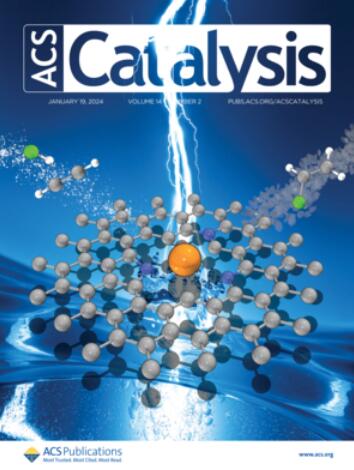非晶化诱导高密度欠配位铟位点增强电催化尿素合成
IF 11.3
1区 化学
Q1 CHEMISTRY, PHYSICAL
引用次数: 0
摘要
金属催化剂上的欠协调位点对于增强电催化反应至关重要,特别是在必须生成和耦合多个中间体的共还原过程中。然而,传统的合成方法在产生这些低配位位点的能力上是有限的。在这项研究中,我们使用硼氧化物辅助方法开发了一种非晶铟催化剂(A-In@BOx),该催化剂具有独特的低配位数(CN = 3.6)和67.2 wt %的高密度。这种结构特征显著提高了尿素合成的催化效率,在−0.45 V条件下,相对于RHE的法拉第效率为51.43%,产率为2317.58 μg - 1 mgcat-1。A-In@BOx上的未配位铟位点(UC-In)提高了NO3 -向NO2 -的转化,有效地生成了*NO2作为碳氮耦合的关键氮中间体,而固有的有限的CO2还原活性维持了*CO2作为主要碳中间体的地位。我们的综合原位光谱和理论模拟表明,从UC-In到*NO2的电子转移显著降低了CO2质子化的自由能垒,从1.77 eV降低到0.04 eV,从而促进了关键的* COOH-NO2中间体的形成。这一突破不仅为优化尿素合成提供了一条新的途径,而且阐明了金属欠配位的共还原机制,为高选择性催化剂的设计铺平了道路。本文章由计算机程序翻译,如有差异,请以英文原文为准。

Amorphization Induces High-Density Undercoordinated Indium Sites for Enhanced Electrocatalytic Urea Synthesis
Undercoordinated sites on metal catalysts are pivotal for enhancing electrocatalytic reactions, particularly in processes like coreduction, where multiple intermediates must be generated and coupled. Traditional synthesis methods, however, are limited in their ability to produce these low-coordination sites. In this study, we developed an amorphous indium catalyst (A-In@BOx) using a boron oxide-assisted method that achieves a uniquely low coordination number (CN = 3.6) with a high density of 67.2 wt %. This structural characteristic significantly enhances the catalytic efficiency for urea synthesis, achieving a yield rate of 2317.58 μg h–1 mgcat–1 and a Faradaic efficiency of 51.43% at −0.45 V versus RHE. The undercoordinated indium sites (UC–In) on A-In@BOx improve the conversion of NO3– to NO2–, effectively generating *NO2 as a crucial nitrogen intermediate for carbon–nitrogen coupling, while the inherently limited activity for CO2 reduction maintains *CO2 as the primary carbon intermediate. Our integrated in situ spectroscopy and theoretical simulations show that electron transfer from UC–In to *NO2 markedly reduces the free energy barrier for CO2 protonation from 1.77 to 0.04 eV, thus promoting the formation of the key *COOH–NO2 intermediate. This breakthrough not only offers a fresh pathway for optimizing urea synthesis but also elucidates the coreduction mechanisms at undercoordinated metal sites, paving the way for the design of highly selective catalysts.
求助全文
通过发布文献求助,成功后即可免费获取论文全文。
去求助
来源期刊

ACS Catalysis
CHEMISTRY, PHYSICAL-
CiteScore
20.80
自引率
6.20%
发文量
1253
审稿时长
1.5 months
期刊介绍:
ACS Catalysis is an esteemed journal that publishes original research in the fields of heterogeneous catalysis, molecular catalysis, and biocatalysis. It offers broad coverage across diverse areas such as life sciences, organometallics and synthesis, photochemistry and electrochemistry, drug discovery and synthesis, materials science, environmental protection, polymer discovery and synthesis, and energy and fuels.
The scope of the journal is to showcase innovative work in various aspects of catalysis. This includes new reactions and novel synthetic approaches utilizing known catalysts, the discovery or modification of new catalysts, elucidation of catalytic mechanisms through cutting-edge investigations, practical enhancements of existing processes, as well as conceptual advances in the field. Contributions to ACS Catalysis can encompass both experimental and theoretical research focused on catalytic molecules, macromolecules, and materials that exhibit catalytic turnover.
 求助内容:
求助内容: 应助结果提醒方式:
应助结果提醒方式:


